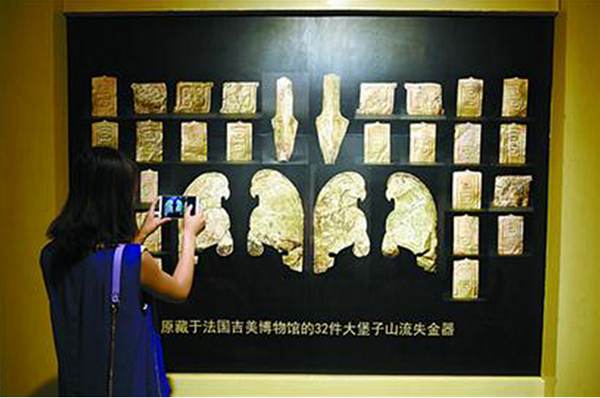

Due to an ineffective international treaty and unsound laws and regulations, China still has a long way to go to recover all of its looted relics that have wound up overseas, the Liberation Daily, an official daily newspaper of China, reported.

A visitor takes photo of the gold ornaments French collectors handed over to China, July 20, 2015. [Photo/Xinhua]
A rare, 3,000-year-old bronze vessel thought to have been ransacked from the Old Summer Palace in Beijing in 1860 fetched 410,000 pounds ($581,000) at auction in Kent, in the south of England on April 11, which attracted attention on the fate of stolen Chinese relics overseas.
Statistics issued by the China Cultural Relics Academy indicate that over 10 million snatched Chinese cultural relics were shipped to European countries, America, Japan and Southeast Asian countries since the Opium War, around 1840. More than 1 million of these items are grade 1 and 2 cultural relics of China.
Chinese cultural relics were lost in many ways, such as being raided during war, foreign institutions’ and individuals’ purchasing, illicit smuggling as well as legal trade.
For example, numerous Chinese cultural relics were taken in the 1840s from the Old Summer Palace during the Opium War, in 1900 when China was invaded by the Eight-Power Allied Forces and during the Sino-Japanese War of last century.
Early in 2002, China’s State Administration of Cultural Heritage set a special fund for purchasing Chinese cultural relics with high artistic value. In the same year, a law protecting cultural relics was also revised to allow individuals to collect works of art, which promoted recovery of looted Chinese cultural relics overseas.
In addition, many Chinese non-governmental organizations stepped up efforts to recover the relics.
Despite efforts made in the past decade, China still faces barriers including the laws surrounding recovery of relics.
Although the first international treaty dedicated to the fight against illicit trafficking of cultural property was adopted by UNESCO in 1970, and over 90 countries have become parties of the treaty, it is a pity that the treaty is not internationally binding to former illegal acts and non-convention countries like Britain, which currently houses many Chinese cultural antiques.
Moreover, as it has been a long time since the relics were originally taken, it is hard for China to collect the evidence needed to recover the artifacts.
What made things even worse is that 19 foreign museums and institutions including the Louvre Museum in Paris and the Metropolitan Museum of Art in the U.S. announced in 2002 their refusal to return cultural relics to their original home countries.
These cultural antiques can be recovered in many ways, including purchasing at a high price.
In 2002, the state-owned China Poly Group acquired the bronze heads of an ox, tiger, and monkey at an auction that were originally removed from the Old Summer Palace fountain, spending tens of millions of yuan. However, the country would be overburdened if it were to recover all of its relics by auction.
Xie Chensheng, honorary president of the China Society of Cultural Relics noted that China is supposed to recover such relics through legal avenues under the framework of international conventions, instead of purchasing, which will only make the illegal activity legal.
Xie also stressed that not all cultural relics need to be recovered but those with high artistic values that were stolen during war times were especially important.
 Fire brigade in Shanghai holds group wedding
Fire brigade in Shanghai holds group wedding Tourists enjoy ice sculptures in Datan Town, north China
Tourists enjoy ice sculptures in Datan Town, north China Sunset scenery of Dayan Pagoda in Xi'an
Sunset scenery of Dayan Pagoda in Xi'an Tourists have fun at scenic spot in Nanlong Town, NW China
Tourists have fun at scenic spot in Nanlong Town, NW China Harbin attracts tourists by making best use of ice in winter
Harbin attracts tourists by making best use of ice in winter In pics: FIS Alpine Ski Women's World Cup Slalom
In pics: FIS Alpine Ski Women's World Cup Slalom Black-necked cranes rest at reservoir in Lhunzhub County, Lhasa
Black-necked cranes rest at reservoir in Lhunzhub County, Lhasa China's FAST telescope will be available to foreign scientists in April
China's FAST telescope will be available to foreign scientists in April "She power" plays indispensable role in poverty alleviation
"She power" plays indispensable role in poverty alleviation Top 10 world news events of People's Daily in 2020
Top 10 world news events of People's Daily in 2020 Top 10 China news events of People's Daily in 2020
Top 10 China news events of People's Daily in 2020 Top 10 media buzzwords of 2020
Top 10 media buzzwords of 2020 Year-ender:10 major tourism stories of 2020
Year-ender:10 major tourism stories of 2020 No interference in Venezuelan issues
No interference in Venezuelan issues
 Biz prepares for trade spat
Biz prepares for trade spat
 Broadcasting Continent
Broadcasting Continent Australia wins Chinese CEOs as US loses
Australia wins Chinese CEOs as US loses